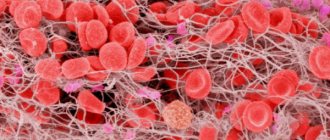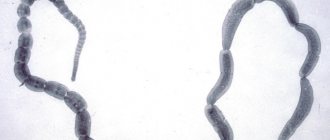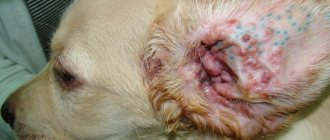Diseases of infectious etiology, provoked by pathogenic fungi, are called dermatophytoses. Pathological changes lead to damage to keratinized tissues, the epidermis itself, fur and claws.
In cats, dermatophytosis manifests itself primarily in changes in the condition of the coat. The fur becomes brittle and thin, and the skin becomes covered with scales. Severe itching and peeling with the development of dermatophytosis in a pet leads to scratching and damage to pathogenic bacterial microflora, which in turn complicates the course of the underlying disease.
In the sources you can see the definition of dermatophytosis as lichen. The normal functioning of the defense forces allows the body to independently fight pathogens. Cure occurs within a few weeks. The greatest danger is that lichen is a contagious disease and can be transmitted from one animal to another. The owner can also become infected with dermatophytosis from a domestic cat.
In purebred cats, due to genetic changes, self-healing when infected with dermatophytosis occurs extremely rarely. It is necessary to contact a veterinary hospital for specialist help. All fungal infections are difficult to treat with drug therapy, and lichen is no exception.
A competent doctor will help you choose the most appropriate type of treatment for the animal, based on the individual characteristics of the patient.
Dermatophytosis in cats - what is it?
All fungal infections are united under one name - dermatophytosis. This disease can affect not only animals, but also people. Develops on hair (fur), claws. In some forms, the spores accumulate in the inner and outer layers of the skin. The infection is caused by fungi of the species Microsporum gypseum, Microsporum canis, and less commonly Trichophyton. Unfortunately, any animal can become infected with them. The disease is common among felines. It has been noted that it can go away on its own without treatment, but then the individual becomes a passive carrier. Animals with weak immunity have difficulty coping with infection. It is fraught with complications and even death.
The danger of this disease is that it is transmitted. Not only other animals, but also owners are at risk. Therefore, it is extremely important to know how the infection manifests itself, how it is transmitted and how it is treated.
Are there risks of human infection from a cat?
Ringworm can be transmitted quite easily to people, especially children. This is why it is important to take appropriate steps to minimize exposure to fungus while treating your cat (see above: disinfecting the apartment and environment). Ringworm is most likely to be transmitted and cause clinical signs in people with suppressed immune systems.
If anyone in the home develops skin lesions, especially small patches of thickened or red skin with raised, scaly edges, medical attention should be sought. Ringworm in humans is generally very treatable. However, ringworm spores can remain infectious for up to 18 months in the environment. Consequently, re-infection may occur. When handling infected animals, it is important to wear gloves and wash your hands thoroughly afterwards.
Signs
Dermatophytosis in cats can manifest itself in different ways. Everything will depend on the general condition of the body and immunity. In most cases, the affected area on the animal's body becomes bald. Scaly gray crusts may form on the skin.
Most often, fungal infection is localized on the paws, face and ears. The disease does not manifest itself as severe itching, it may be absent altogether, so special treatment is not required to combat the symptoms.
Signs of dermatophytosis in cats may be different. The disease manifests itself in the following forms:
- Extensive damage to the skin. There is peeling and a change in color to red.
- Quite deep inflammation of the dermis. A local type of furunculosis occurs.
- Formation of acne (comedones).
- Inflammation of the hair follicles on the chin.
- Formation of crusts on the skin (diffuse alopecia).
- Increased production of sebaceous gland secretion.
- Dermatitis with large lesions.
It is worth noting that the fungus can “settle” not only on the body, but also on the claws. This form of the disease is called onychomycosis. Rarely diagnosed. In some cases, doctors resort to removing the damaged phalanx.
Individuals of the Persian breed are susceptible to pseudomycetoma. A fungal disease of this form occurs in the form of a dense subcutaneous formation. This is where pathogenic microorganisms develop. They penetrate into the inner layers through destroyed follicles. This can lead to the formation of fistulas. When pseudomycetoma is removed, there is a high probability of relapse if the animal has not completed a course of antifungal therapy.
Symptoms of ringworm
During the incubation period, humans can infect cats.
Dermatophytosis is an extremely contagious disease that can be transmitted from one animal to another, and then to humans. The infection can persist in the pet’s body for up to 6 years and not reveal itself in any way. During the incubation period (8-22 days), the fungus actively develops and spreads, although symptoms of the disease do not appear. Therefore, the animal is capable of infecting people and other pets.
As the disease progresses, cats' fur becomes brittle and round bald patches form. They are localized in the head area (on the ears, crown) and at the tip of the tail. Sphynx cats develop red sores on their bodies. At first these may be small foci of the disease, which later merge into one spot. Bald spots are not always noticeable in long-haired breeds, as they are hidden behind the hair. The skin takes on a grayish tint and begins to peel off. The affected areas are itchy and cause discomfort to the cat. Suppurations appear, which later become scars. Without treatment, dermatophytosis can lead to inflammation of the hair follicles.
Diagnostics
In order to diagnose dermatophytosis in cats in a timely manner, it is recommended to do fungal tests for any damage to the skin. To do this, you need to visit a specialized clinic. At the appointment, the doctor will examine the damage and assess the condition of the entire skin. A rapid test is also required to determine the presence of parasites. After this, you need to check whether there is a fungal infection on the animal’s fur. To do this, you will need to turn off the lights in the office or go into a dark room and use ultraviolet light to examine the cat’s body, paws, head, and tail. Areas containing fungal spores glow yellow-green, and quite brightly. However, if the lesion is caused by Microsporum canis, then this method is effective only in 50% of cases. The fact is that this type of fungus may not fluoresce.
It is important to know some points:
- If the owner of the animal has already started treating the fur with preparations (ointments, creams, lotions), then there will be no reaction to ultraviolet radiation.
- When working with a Wood's lamp, you must take into account that if you do not warm it up, there is a high probability of obtaining a false result.
The glow method, although it has disadvantages, is widely used. It's pretty simple. Cats tolerate such diagnostics calmly. The only thing is that using ultraviolet light can only make a preliminary diagnosis. To confirm it, you will need a wool study. To do this, the doctor pulls out several hairs. Places them in mineral oil and conducts a microscopic examination. This allows you to determine the presence of spores.
However, in medicine, bacterial culture is considered the most reliable analysis. To do this, particles are combed from the animal’s fur using a special stiff brush, which will become the material for research. Next, they are placed in a container and sown on a nutrient medium for some time. Thanks to this analysis, it is possible to establish not only the presence of a fungal infection, but also the type of microorganisms. And this, accordingly, will allow the doctor to choose effective treatment.
How is ringworm transmitted?
Ringworm is highly contagious and transmission occurs through direct contact with the fungus. It can be spread by direct contact with an infected animal or person, or by handling contaminated objects, or by touching contaminated surfaces.
Fungal spores can remain dormant on combs, brushes, bowls, furniture, bedding, carpet, or other environmental surfaces for many months (sometimes up to 18 months).
Ringworm is contagious and can be transmitted between infected and uninfected people through direct contact or contact with contaminated objects. Contact with the ringworm fungus does not always lead to infection. The degree of environmental pollution is an important factor in the development of ringworm infection, as is the age of the person or animal.
Healthy adults are usually resistant to infection unless there is damage to the skin such as scratches or wounds. Older adults, young children, and adults with weak immune systems or sensitive skin are especially susceptible to ringworm infection.
If your child has ringworm, he or she may have picked it up from a family cat, dog, or even another child at school. If anyone in your family develops suspicious skin lesions, contact your doctor immediately.
How long does it take for shingles to appear?
The incubation period between exposure to dermatophytosis spores and the development of ringworm lesions usually ranges from seven to fourteen days. In some cases, it may take up to 21 days for signs of infection to appear.
Before starting treatment
Before you begin treatment for dermatophytosis in cats, you will need to treat the habitat. We are talking about the room where the animal lives. It is important to understand that if an individual is already infected with a fungus, then its spores remain on all places and objects with which it has been in contact. Naturally, this will reduce the effectiveness of treatment. Therefore, it is recommended to do the following:
- Clean the entire living space daily using a vacuum cleaner. Particular attention is paid to those places where the pet likes to spend time.
- If possible, treat surfaces with chlorine-based disinfectants.
- If two or more cats (or other animals) live in one room, then it is advisable to carry out disinfection using special antifungal sprays.
Prevention
Everything here is extremely simple - you must carefully observe the dog’s hygiene . When walking, areas where stray dogs gather should be avoided. An important point is that the dog has proper nutrition and balanced physical activity.
It is simply impossible to protect your pet from a fungal infection, but periodic visits to the veterinarian will make it possible to prevent adverse consequences.
You should not neglect visiting a specialist. It is important to know that fungal infections are prone to adapting to drugs and mutating. Self-prescribed medications can develop resistance in the fungus.
Local treatment
Most often, dermatophytosis in cats is treated at home using ointments, lotions, and creams. However, owners are still advised to contact a veterinary clinic to select effective antifungal therapy.
Before starting treatment, it is important to trim the animal's fur. Only after this is processing carried out. For it they use:
- Preparations with clotrimazole and miconazole in the form of creams or lotions. The affected areas are treated twice a day. When applying the drug, be sure to cover a larger area - expand its boundaries by 1-2 cm.
- Medicinal shampoo. It should contain antifungal agents (enilconazole, miconazole). There are also shampoos with the addition of chlorhexidine (4%). Used for extensive lesions. Use shampoo no more than twice a week.
Systemic therapy
As a rule, dermatophytosis in cats is treated with topical medications within three weeks. If therapy does not produce results, then the doctor decides to prescribe a systemic course. It has side effects, so you need to be treated under the supervision of a specialist, taking regular blood tests. This is necessary in order to track the number of white blood cells.
The duration of the course of taking systemic drugs is one and a half to two months. It may include Itraconazole or Griseofulvin. The first is prescribed in an amount of 10-20 mg. Take it either every other day or daily. The dosage of the second drug is 25-60 mg/kg. Cats are given it 1-2 times a day. Itraconazole is considered less toxic. It is more easily tolerated by animals and rarely causes side effects.
These drugs can disrupt development, so they should not be prescribed to kittens under three months old and to individuals who are expected to give birth.
If the fungal infection has spread to the claws, then Flucostat, Fluconazole, and Diflucan are prescribed. These drugs are quite effective. Dosage – 20-30 mg once a day.
"Vacderm-F"
Vaccines are used as a preventive measure, as well as a treatment for dermatophytosis in cats. The products are considered universal because they have a wide spectrum of action. If the animal has not been vaccinated, it is recommended to use the Vakderm-F vaccine for treatment. It is designed specifically for cats and is most effective in combating fungal infections.
Duration of treatment
Having decided what and how to treat dermatophytosis in a cat, it is necessary to say a few words about the duration of therapeutic courses. It is important to remember that this should be monitored by a qualified doctor. It is he who prescribes medications, determining the duration of their use. Afterwards you will need to do tests for the presence of pathogens. If the result is negative, then the course is repeated at seven-day intervals. Then another sample is taken. And if it is also negative, then you can finish the treatment.
In a situation where the tests raise doubts among the veterinarian, therapy continues. The recovery of a pet can be judged only after receiving at least two negative samples.
ethnoscience
Some owners use herbal medicine to combat dermatophytosis in cats. When treating at home, it is recommended to use a collection of herbs. It should include:
- birch leaves;
- St. John's wort;
- sagebrush;
- medicinal marigolds;
- Oak bark;
- marsh cudweed;
- meadow clover;
- tansy (inflorescences);
- yarrow;
- dried sage leaf;
- chamomile (flowers);
- burdock leaves.
An infusion is prepared from this herbal collection. To do this, pour boiling water over the mixture. Dosage – 0.5 l per tablespoon. The maximum infusion time for the decoction is 3 days. For prevention, the animal is given 4-5 ml before feeding 30 minutes. Sick individuals take 8-10 ml 2-3 times a day.
If this pathology causes ulcers or wounds to form on the cat’s body, then you can use calendula infusion. It promotes rapid healing.
Danger to humans
Dermatophytosis in cats (in the photo you can see what sick animals look like) is not so harmless. The disease poses a danger not only to other individuals, but also to humans. The fungus can enter through wounds and abrasions on the skin. At risk are people with weakened immune systems, children and the elderly.
If the animal is sick, the owner will have to limit not only contact with it, but also the pet’s movement around the rooms. It is better to handle a cat with gloves. It is also very important to perform proper hygiene procedures. Be sure to wash your hands thoroughly with soap and shower. In addition, it is necessary to clean and treat surfaces with special disinfectants. Using a steam generator is effective in combating fungus.
Risk group and routes of transmission
Dermatophytosis is a group of contagious fungal diseases that affect the skin and coat of mammals. Dermatophytes are infections caused by a certain type of fungus that the skin considers as a food source.
These include:
- Ringworm – trichophytosis;
- Favus;
- Athlete's foot.
Dermatophytosis in cats
The risk group includes the following categories of pets:
- Long-haired breeds;
- Animals leading an outdoor and semi-indoor lifestyle;
- Nursery inhabitants;
- Exhibition participants;
- Weakened individuals;
- Aged animals;
- Kittens and puppies.
Ways of infection with dermatophytosis:
- Contact with a carrier of the disease;
- Walking outside – contact with contaminated areas of soil and grass;
- Using the same hygiene items for several pets;
- Hunting for rodents.











